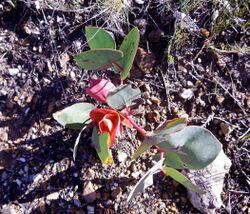Biology:Protea cordata
| Protea cordata | |
|---|---|

| |
| Scientific classification | |
| Kingdom: | Plantae |
| Clade: | Tracheophytes |
| Clade: | Angiosperms |
| Clade: | Eudicots |
| Order: | Proteales |
| Family: | Proteaceae |
| Genus: | Protea |
| Species: | P. cordata
|
| Binomial name | |
| Protea cordata | |
Protea cordata (heart-leaf sugarbush; hartblaarsuikerbos (Afr.)) is a plant species native to Southern Africa that grows on woody soils or in the soil.
The red, bald-sheared trunk is unbranched and reaches a length of 500 mm. Brown, lance-shaped, scaly leaves appear at the base of the stem, and some stalkless, heart-shaped leaves zigzag along the tip, while others gradually shrink.[2]
Small mammals and insects have been found to contribute to the reproduction and distribution of the Protea cordata, as it has been determined to be a self-incompatible species.[3]
Brown dry paper bracts form a cup – shape that surrounds a cream – colored flower with red tip, with an orange-brown flower at the base of the flower. A new trunk grows from the woody subsoil, while the old one dies after one or two years and is finally blown away. Each reversed fruit contains a single seed and is covered by a thick layer of green, brown or orange-brown leaves, covered with a thin, white, upturned, yellow, green or yellowish orange fruit.
References
- ↑ Rebelo, A.G.; Mtshali, H.; von Staden, L. (2020). "Protea cordata". IUCN Red List of Threatened Species 2020: e.T113209109A157955661. doi:10.2305/IUCN.UK.2020-3.RLTS.T113209109A157955661.en. https://www.iucnredlist.org/species/113209109/157955661. Retrieved 18 November 2021.
- ↑ "Protea cordata | PlantZAfrica". http://pza.sanbi.org/protea-cordata.
- ↑ "Floral biology and breeding systems of geoflorous Protea species (Proteaceae)". https://www.sciencedirect.com/science/article/pii/S0254629916338066#s0080.
Wikidata ☰ Q18080383 entry
 |


